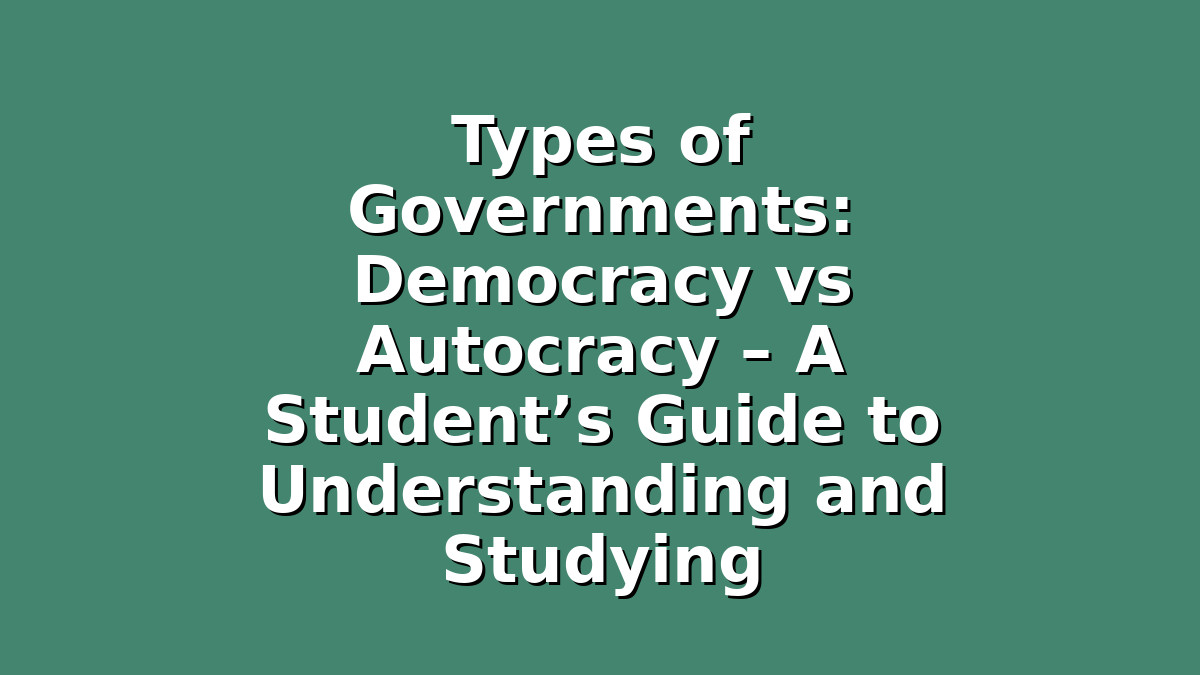When preparing for exams or enhancing your general knowledge, understanding different types of governments is essential. Two of the most significant forms of government you’ll encounter in your studies are democracy and autocracy. These systems shape how countries are run, how leaders are chosen, and how citizens participate in decision-making. Whether you’re studying political science, history, or social studies, grasping the differences between democracy and autocracy can boost your exam performance and help you confidently discuss global affairs.
In this article, we’ll break down the key features of democracy and autocracy, provide useful study tips for remembering their characteristics, and offer strategies for comparing these government types effectively. Let’s get started!
—
1. Understanding Democracy: Features and Study Tips
What is Democracy?
Democracy is a system of government where power is held by the people, either directly or through elected representatives. Its core principle is that citizens have a say in decisions that affect their lives. Examples of democracies include the United States, India, and many European countries.
Key Features of Democracy:
– Popular Sovereignty: The authority to govern comes from the people.
– Free and Fair Elections: Leaders are elected through transparent voting processes.
– Rule of Law: Everyone, including leaders, must follow the law.
– Protection of Rights: Citizens have protected freedoms, such as speech, assembly, and religion.
– Pluralism: Multiple political parties and opinions coexist.
Study Tips for Democracy:
– Create Flashcards: Write down key terms like “popular sovereignty,” “rule of law,” and “pluralism” on one side, and their definitions on the other. Review these regularly.
– Use Real-Life Examples: Relate facts to countries you know. For instance, remember that India holds regular elections with many political parties, highlighting democratic pluralism.
– Summarize Concepts: After reading about democracy, try explaining it aloud in your own words or write a short paragraph summarizing its main features. Teaching someone else is a great way to reinforce your understanding.
– Mind Maps: Visual learners can benefit from creating mind maps that connect democracy’s features to examples, benefits, and challenges.
—
2. Exploring Autocracy: Features and Study Tips
What is Autocracy?
Autocracy is a form of government where one person or a small group has unlimited power. The citizens usually have little or no role in political decision-making. Autocracies often include dictatorships and absolute monarchies. Examples are North Korea and Saudi Arabia (absolute monarchy).
Key Features of Autocracy:
– Centralized Power: Authority is concentrated in the hands of a single ruler or a small elite.
– Limited Political Freedom: Citizens have restricted rights, and opposition is often suppressed.
– Lack of Free Elections: Leaders are not elected by the people or elections are controlled.
– Rule by Decree: The leader can make decisions without consulting a legislative body.
– Control Over Media: Information is often censored to maintain the ruler’s power.
Study Tips for Autocracy:
– Compare and Contrast: Use a two-column chart to list features of autocracy on one side and democracy on the other. Visual comparisons help solidify differences.
– Timeline Practice: Some autocracies change over time. Create timelines showing how power shifted or when autocratic rulers took control.
– Practice Exam Questions: Write answers to typical exam questions like “Describe two features of autocracy” to develop clear, concise responses.
– Watch Documentaries or Videos: Sometimes seeing how autocracy works in real life can make the concept more memorable.
—
3. How to Effectively Compare Democracy and Autocracy for Exams
Understanding democracy and autocracy individually is important, but many exams require you to compare the two. Here are some strategies to help you prepare:
Focus on Key Differences:
– Power Source: Democracy = power from the people; Autocracy = power from one person or group.
– Citizen Participation: Democracy encourages participation; autocracy limits it.
– Decision-Making Process: Democracy involves debate and voting; autocracy relies on the ruler’s decisions.
– Rights and Freedoms: Democracies protect freedoms; autocracies often restrict them.
Study Tips for Comparison:
– Create Venn Diagrams: Use Venn diagrams to visually organize similarities and differences. In most cases, you’ll find few overlaps, making it easier to remember key contrasts.
– Practice Writing Comparative Essays: Draft essays comparing democracy and autocracy. Start with an introduction defining both, followed by paragraphs that highlight differences and similarities, and end with a conclusion summarizing your points.
– Use Mnemonics: Make up a mnemonic to remember differences. For example, “P.I.D.E.” could stand for Power source, Involvement, Decision-making, and Equality (or lack thereof).
– Group Discussions: Talking through comparisons with classmates can deepen understanding and reveal new insights.
—
Conclusion
Studying types of governments like democracy and autocracy is not just about memorizing definitions—it’s about understanding how the world functions politically and what impact these systems have on people’s lives. By breaking down their features, using real-world examples, and employing study techniques like flashcards, charts, and mind maps, you can master this topic with confidence.
Remember to approach your studies with curiosity and persistence. The more you engage with the material actively—through writing, speaking, and visual aids—the better you’ll retain the information. Good luck with your exams, and keep exploring the fascinating world of governments!
—

Responses